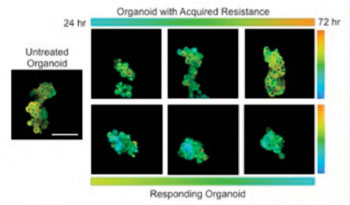Effectiveness of Chemotherapy Gauged by Optical Monitoring of Tumor Organoids
By LabMedica International staff writers
Posted on 10 Nov 2014
Laser-modulated optical metabolic imaging of organoids derived from primary breast tumors can gauge the therapeutic response of the cancer to antitumor drugs.Posted on 10 Nov 2014
Investigators at Vanderbilt University (Nashville, TN, USA) generated organoids from primary breast tumors by growing biopsy specimens from the tumors in a nutrient-rich collagen gel that enabled the tumor to retain its three-dimensional structure and included supporting cells from the primary tumor's microenvironment.

Image: Time sequence shows how the test differentiates between drug-resistant tumors, top, that continue to grow and tumors that respond to the treatment, bottom, that begin to shrink. Shades of blue indicate low levels of metabolic activity while yellow and orange represent high activity levels (Photo courtesy of Vanderbilt University).
Fluorescence imaging was used to monitor the metabolic state of the organoids. This technique utilized a laser that caused two key metabolic enzymes, FAD (flavin adenine dinucleotide) and NADH (nicotinamide-adenine dinucleotide) in the cells to fluoresce, with the strength of the fluorescence dependent on the health of the organoid.
The method was tested extensively in mice and with six samples of human breast tumors using four anticancer drugs commonly used to treat breast cancer and two experimental drugs. Results revealed that as early as 24 hours after treatment with the anticancer drug, the optical metabolic imaging index of responsive organoids decreased and was further reduced when effective therapies were combined, with no change in drug-resistant organoids. Drug response in mouse xenograft-derived organoids was validated with tumor growth measurements in vivo and staining for proliferation and apoptosis.
Senior author Dr. Melissa C. Skala, assistant professor of biomedical engineering at Vanderbilt University, said: "We hit the tumor with a punch and see how it responds. It is cheap and fast and adaptable to high-throughput screening so it can be used to test dozens of drugs or drug combinations at the same time. We hope that our test will significantly improve the odds of survival of breast cancer patients by allowing doctors to identify the most effective but least toxic form of chemotherapy for each individual patient before the treatment begins.”
The study was published in the September 15, 2014, issue of the journal Cancer Research.
Related Links:
Vanderbilt University













